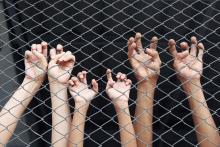Commentary

ARE CLEVERLY branded fishing hats, stuffed animals, and fancy dinners to blame for the raging opioid and heroin epidemic in the U.S.?
Most of us know the breathtaking scope of that epidemic. People are dying of overdoses at a higher rate than ever in our history—nearly 80 deaths every single day. Four of every five heroin users trace their addiction back to prescription painkillers or opioids.
Less well known is the unethical corporate sales and lobbying blitz that helped trigger the epidemic. During the two decades when addiction rates climbed to unprecedented numbers, multiple pharmaceutical companies spent billions of dollars pushing physicians and patients into a downward spiral of painkiller overprescription and abuse.
Corporate painkiller promotions included dinners and junkets for physicians and direct outreach to patients. One company even funded a “pain guide” that cheerfully promoted the life-changing benefits of opioids while citing multiple “disadvantages” of over-the-counter medications such as ibuprofen. At the same time, the industry was using insider ties to rewrite the medical guidelines that justified the rash of prescriptions.
The efforts paid off. In 2010 alone, physicians wrote 254 million prescriptions for opioids, and pharmaceutical corporations raked in $11 billion in opioid sales.
Multiple companies are culpable, but the most high-profile effort was Purdue Pharma’s promotion of OxyContin. Purdue’s marketing centered on the claim, embossed on its complementary fishing hats and plush toys, that each dose of the drug provided 12 hours of relief. The lengthy duration was the factor that distinguished OxyContin from other, cheaper alternatives.
Unfortunately, for many patients, the drug’s effects did not actually last that long, according to multiple clinical trials, patient experiences, and physician reports. When OxyContin’s effects wore off before the next scheduled dose, it created desperate patients—and what one neuropharmacologist calls “the perfect recipe for addiction.” In one New York county, for example, between 1996 and 2011 opioid pill use increased 1,136 percent and heroin use rose 425 percent.

IN SEPTEMBER, President Obama signed a new 10-year agreement with Israel’s Prime Minister Benjamin Netanyahu committing a total of $38 billion in military assistance.
President Obama noted that this—the most significant support package ever offered to Israel—demonstrated his unparalleled commitment to that state’s security. Shortly thereafter, Obama, speaking before the U.N., cautioned Israel that it “cannot permanently occupy and settle Palestinian land.” The two messages combined made the point that the U.S. can help to protect Israel from external foes, but if Israel wants to be protected from internal challenges, it must change its behavior vis-a-vis the Palestinians.
Just a few weeks later, Netanyahu announced that he was building new settlement units in colonies deep in the West Bank and maintaining ongoing plans to expand settlements in other sensitive areas of the occupied lands—in Arab areas of Jerusalem, in the heart of Hebron, and around Bethlehem.
These are clear provocations and together point to Israel’s intention to maintain its control over the West Bank, making impossible the establishment of a viable Palestinian state.
The Obama administration reacted harshly to the Israeli move. A White House spokesperson noted that every U.S. administration since 1967 has opposed settlements in the occupied lands, the expansion of which will only further frustrate a two-state solution to the Israeli-Palestinian conflict.
The White House also accused Netanyahu of violating his commitment to the U.S. that he would refrain from any further settlement expansion. The State Department “strongly condemned” the Israeli plan, referring to the expansion as yet “another step toward cementing a one-state reality of perpetual occupation.”

ON ELECTION DAY, Pulitzer Prize-winning Washington Post reporter Mary Jordan suggested that we may need “a Reconciliation Commission, starting as soon as the results come in—no matter who wins.” In this troubling national moment, stories gleaned from historic truth and reconciliation processes can offer glimpses of hope and guide us forward.
A boy named Free Spirit was only 4 years old when he was wrenched away from his family and forced into a Canadian residential school. A nun gave him a new pair of shoes, which he plunged into a sink filled with water. He was shocked by the beating he received. His Algonquin people always soaked their new moccasins and chewed on them to soften the leather.
Decades later, during Canada’s 2011 Truth and Reconciliation hearings in Halifax, Nova Scotia, Free Spirit joined scores of witnesses who shared their stories of suffering in schools whose purpose was to annihilate their culture. Each evening, all the tissues used to capture the day’s tears were gathered and released into the Sacred Fire that burned outside. There they mingled with ashes that had been carried from previous hearings in other cities.
In the United States, the first large-scale truth and reconciliation process was launched in Greensboro, N.C., in 2005. Its focus was the 1979 Greensboro Massacre, in which members of the Ku Klux Klan and American Nazi Party opened fire on marchers demanding economic and racial justice, killing five and wounding 10.
As the hearings opened, Gorrell Pierce, who was the Grand Dragon of the Federated Knights of the KKK in 1979, strode in with a cadre of young white men. African-American community activist and pastor Nelson Johnson, who was wounded in the attack and lost five of his closest friends that day, immediately stood. He walked across the auditorium and made his way down that row of men, shaking every hand and thanking them for coming. Nelson admitted later that it wasn’t his first impulse, but that as a Christian he knew he needed to bring his best self to that encounter and try to reach out to the best self within Pierce.

BETWEEN 1980 and 2013, the federal prison population increased by 800 percent, according to the Department of Justice, at a far-faster rate than the Bureau of Prisons could handle. By 2013, approximately 15 percent of BOP’s prisoners were housed in for-profit prisons.
In August, the Department of Justice (DOJ) announced that it will no longer contract with private prisons for housing federal prisoners. “[Private prisons] simply do not provide the same level of correctional service, programs, and resources,” said Deputy Attorney General Sally Yates. “They do not save substantially on costs; and as noted in a recent report by the Department’s Office of Inspector General, they do not maintain the same level of safety and security.”
Within weeks, Secretary of Homeland Security Jeh Johnson responded to DOJ by directing his teams “to evaluate whether the immigration detention operations conducted by Immigration and Customs Enforcement [ICE] should move in the same direction” — to evaluate whether ICE should eliminate contracts with for-profit immigration detention companies. There is no need for a review. Multiple reports, from human rights organizations and the Department of Justice itself, give damning evidence against the inhumane practices of for-profit prisons and detention centers.
As the leader of a Christian denomination, I feel a deep obligation to pay attention to foundational passages from our sacred texts in the midst of the current challenges we face as a country. When it comes to prisoners and immigrants, two passages are bedrock for me. Leviticus 19:34 reminds us to love foreigners as we love ourselves. In Matthew 25:31-46, Jesus prioritizes the vulnerable. He issues a clear call for those who follow him to care for the stranger, the prisoner, the naked, the hungry, and the thirsty.

AFTER 52 YEARS of war and four years of negotiations, a peace accord was signed in late September between the Colombian government and FARC rebels. Six days later, a national referendum failed to bring the accord into force.
Within a few days of the referendum, a massive popular movement took to the streets of Colombia’s major cities to ensure that negotiations continued. Then, Colombian president Juan Manuel Santos, but not his FARC counterpart, was awarded the Nobel Peace Prize.
These events have been a roller-coaster ride for Colombian churches, which have been working toward this accord for decades. Colombian Christians have played an important, if often behind-the-scenes, role in advancing peace in this country.
The Catholic Church helped facilitate the highly secret early dialogue between government and rebel leaders, paving the way for the current peace process. Mennonites have worked for more than 25 years for the right to conscientious objection in a country with mandatory military service for all males. In a landmark decision, this year the Colombian military officially granted conscientious objector status to a potential recruit, Juan José Marín Gómez.
In 2015, FARC guerrillas called on “civil society and churches” to monitor their unilateral ceasefire. The Interchurch Dialogue for Peace in Colombia (DiPaz), which includes Protestants, Anabaptists, and Catholics, jumped at the opportunity. “We worked with other civil society organizations and contacted networks of churches all over Colombia, seeking information any time there were reports of a possible ceasefire violation,” said Angélica Rincón, who coordinated the monitoring for DiPaz. “In one of our first surveys, we heard back from numerous pastors in conflict areas saying that this was the most peace they had ever experienced.” The ceasefire held, and conflict-related violence dropped to the lowest levels in more than 50 years.

LAST DECEMBER, my daughter, Zipporah—who has taken to acting out the Christmas story using our wooden nativity set—observed that our crèche was missing a “mean king” figurine. That got me to thinking: I have never seen a nativity set with a King Herod figure.
We tend to close the curtains and go home for a family dinner right after the Magi bow before Jesus with their gifts of gold, frankincense, and myrrh.
But after the Magi head home, Joseph is warned in a dream to escape Herod’s genocidal tyranny by fleeing to Egypt with his wife and child.
We don’t know how the Holy Family was treated when they reached that foreign country. Were they welcomed or feared? Did Egyptians help this vulnerable family to resettle or did local carpenters fret that Joseph might steal their jobs? Was Jesus befriended by other children or viewed as a potential disease-carrier?
Compassion for the world’s estimated 21.3 million refugees—individuals who have fled their countries because of a credible fear of persecution—competes with our own fear that the violence they flee might impact us. This polarized reaction shapes the response by the United States and others to the global refugee crisis.
Nine in 10 Protestant pastors in the United States say that, as Christians, we have a biblical responsibility to care for refugees and other foreigners based on clear biblical injunctions, according to LifeWay Research. The same survey found that only 8 percent of local churches are helping refugees—nearly half acknowledged a sense of fear in their congregations regarding the arrival of refugees.
White evangelicals, by a margin of 2-to-1, were opposed to increasing the number of Syrian refugees admitted to the U.S., according to the Pew Research Center. (A majority of white mainline Protestants were also opposed and a slim majority of Catholics and black Protestants were in favor.) It’s ironic that followers of Jesus would be so afraid of refugees, given that we worship one!

Sexism is dead. So sayeth most men, according to a national survey in August. Women, on the other hand, aren’t quite convinced.
The poll by the Pew Research Center found that 56 percent of men, and only 34 percent of women, said they thought that “sexism no longer was a barrier” to women in this country. (A pair of adjacent headlines on washingtonpost.com summed it up: “Sexism is over, according to most men” immediately preceded “It’s 2016, and women still make less for doing the same work as men.”)
So, welcome to “post-sexist” America.
I imagine it will look a lot like the “post-racist” America that Barack Obama’s election in 2008 supposedly ushered in. At that time, a few days after Obama’s historic election, The Wall Street Journal wrote that “Barack Obama’s election as the first black U.S. president promises to usher in a new era of race relations.”
The paper quoted a senior Obama adviser as saying, “People say he is a post-racial candidate. When people say that, they seem to suggest that we are beyond the issue of race, that issues of race don’t matter.” But Obama will tell you, she continued, that “he thinks race does matter.”
Turns out the president was right.
AND NOW, if the country elects its first woman president this fall, will it be seen as a sign that the country has moved into a new era regarding justice and equality for women?
The campaign itself, of course, hasn’t been encouraging. Some wonder if the level of vitriol aimed at the first woman to receive a major-party presidential nomination is due in large part to the fact that she’s, well, a woman.
Over the last 50 or 60 years, overt sexism—like overt racism—has been made less and less socially acceptable. But a look at basic statistics for, say, women in leadership positions—from CEOs at top companies (4 percent) to members of Congress (19 to 20 percent)—should dispel the delusion that we live in an egalitarian society.

THE CIVIL RIGHTS movement. #BlackLivesMatter. Racial reconciliation. It would be easy for me to imagine the words of Eliza in the musical “Hamilton” and sing, “I’m erasing myself from the narrative.”
At first glance, those statements, movements, and conversations might be mistakenly boiled down to division and brokenness between two Americas—one black, one white.
But I’m neither. I’m “yellow.”
I didn’t choose to erase myself in history, but it’s what I learned. Asian Americans weren’t erased from American history as much as we just didn’t exist in the Plymouth Rock story of East Coast immigration, with its emphasis on Europe’s poor and hungry “huddled masses.” We learned that “assimilation” was as much about becoming “white” as it was about becoming “American.” We learned that the civil rights movement was a fight for equal rights for black Americans, with little connection to “others” like myself. There was no category for someone who looked like me unless it was Oriental, chink, or gook—racial slurs I first heard as a child on suburban playgrounds (and still hear as an adult), slurs tied to a history and wars I knew very little about. In America, race is a social construct divided most simply between black and white.
I also learned that the best I could hope for was to become a model minority, an “honorary white” who would never be considered a “real” American.
So I just didn’t become one. In an act of rebellion, I chose not to become a naturalized U.S. citizen until a few years ago. In the process I learned what it means to opt into a binary conversation with a different, clear, defined perspective. I needed to learn who I was, created as a Korean-American woman carrying God’s image. I needed to learn that Jesus, Mary, Martha, and Esther weren’t blue-eyed or blonde.

THE DEATH PENALTY is almost dead in America. It’s time to pull the final plug.
The number of death sentences imposed is the lowest it’s been in 40 years, and the number of executions is the lowest it’s been in 20. Every year another state abolishes the death penalty. Just this summer Delaware’s highest court declared its death penalty unconstitutional. Several more states are poised to do the same. In fact, only a handful of states are actually still executing. This year Texas and Georgia accounted for 80 percent of the executions.
Most Americans have moved on from the death penalty. When presented with alternatives, a majority of the population says they are against it.
The question is not if we will abolish the death penalty, but when. With the vacancy on the Supreme Court, we are at a critical tipping point. We will someday look back at the death penalty like we look back at slavery, asking, “How did we think that was okay?”
But where will Christians be as this history is made? It’s troubling that the death penalty has succeeded in the U.S. because of Christians, not in spite of us. Eight out of every 10 executions in the past four decades have been in the Bible belt. Where Christians are most concentrated is where capital punishment has flourished. Strange, isn’t it? One would think that those of us who worship a victim of state-sanctioned execution would be suspicious of state violence, that we’d be its biggest critics. But that’s not always the case.
But here’s the deal: I’m hopeful. Only 5 percent of Americans think Jesus would support the death penalty. Christians born after 1980 are overwhelmingly opposed to it. The National Association of Evangelicals has pulled back on its support and the National Latino Evangelical Coalition has called for total abolition. A growing movement of faith-fueled conservatives is leading the way to alternatives to the death penalty in states such as Nebraska, where a referendum to retain a death-penalty ban is on the upcoming ballot. The Movement for Black Lives lists ending capital punishment as one of its top needed reforms. And, as part of the year of mercy, Pope Francis issued a clarion call for a global moratorium.

WEST VIRGINIA’S schoolteachers went on strike on Feb. 22. Although West Virginia has a proud labor history, the state’s two teacher unions (West Virginia Education Association and American Federation of Teachers-West Virginia) do not have the right to strike. After decades of labor movements failing nationally, the Trump age has not seemed like a prime moment for a revival. And West Virginia’s government is firmly in the hands of Republicans.
Fast-forward to March 7. Schools reopened after a statewide strike that lasted two weeks. Teachers procured a 5 percent raise, not only for themselves but for all state employees, from state police to highway maintenance workers to clerks at the DMV.
When schools reopened, the Charleston Gazette-Mail interviewed a woman dropping off her grandchildren at Horace Mann Middle School. She said the children wanted to support their teachers, who every day stood in the cold outside their school. “Every time we’d pass by the teachers [picketing] outside, they’d say, ‘Blow it, Nana. Blow the horn.’”

IT IS INTERESTING, yet not surprising, what the political status of Puerto Rico in the wake of Hurricane María reveals about colonialism, the coloniality of power and gender, emergency government response, and civilian resilience.
Hurricane María was the worst natural disaster Puerto Rico has ever faced and the 10th-most-intense Atlantic storm on record. But Puerto Rico has experienced more than 500 years of colonial activity between the Spanish and North American empires. In addition, because much of Puerto Rico’s religion came to the island through colonization and violence, many Puerto Ricans today still struggle to trust religion and may not see religious organizations as options for help in times of adversity.
My experience in post-María Puerto Rico has made me aware of the still-present legacy of the struggle against white supremacy, racism, heteronormativity, and sexism on the island. As an Afro-Puerto Rican feminist and Christian, I am aware of the ideological and religious struggles inherent in negotiating the nature of our citizenship with the oppressive political dynamics that are exacerbated by a massive natural disaster.
Hurricane María—and its sustained winds of 160 miles per hour—blew the neoliberal veil from the colonizers’ face. The limited response from the federal government in Washington, D.C., along with our unstructured colonial system, increased already-high poverty levels from 44 to 52 percent, according to the University of Puerto Rico, and swelled the numbers of people who left the island looking for better living conditions and a brighter future. After the hurricane, Puerto Rico’s status as an unincorporated U.S. territory blocked aid from several other countries, because the 1920 Jones Act only allows entrance to the island by U.S. ships.
Despite all this, the Puerto Rican people have demonstrated their resilience and capacity to overcome adversity. Citizen mutual aid, in partnership with nonprofit organizations and local churches, proved to be one of the most crucial and immediate forms of assistance after the hurricane.

I AM A CHRISTIAN. That means that I serve a savior who told us he came to free prisoners. At the same time, I live in a nation with more than 2 million prisoners, more than any country in the world.
I am also an affluent white person living in a country that unequally and selectively jails people of color and poor people. And I don’t just live in this country, I help govern it.
As a state representative in Michigan, I am responsible for this situation. The government directly chooses who goes to jail and who doesn’t. Of course, since our democracy practices government “of the people,” that makes all of us responsible for government actions.
How should Christians who are also citizens take action for justice in our law enforcement system? Responding to mass incarceration as Christians can seem daunting, but there are obvious places to begin. One of the clearest places our current system fails the test of equal treatment under the law is in the detention or release of those accused of, but not convicted of, a crime.

THE LONG-OVERDUE transition of power in South Africa this winter, from President Jacob Zuma to Cyril Ramaphosa, has sparked a resurgence of hope among younger church activists in the country. Zuma’s nine years in office were catastrophic to South Africa’s politics and social fabric through entrenched corruption and state capture. Zuma and his cronies enriched themselves while the economy stumbled, with unemployment now above 27 percent and schools and health care in an increasing state of crisis.
While Ramaphosa’s election by the National Assembly has inspired hope, an awakening less heralded and potentially more significant long term has been taking place across the church in South Africa. The theology of hope and liberation that helped fuel the anti-apartheid struggle played a formative role in shaping the public theology of many in the U.S. and around the world. Now a new generation of South African Christian activists is on the cutting edge of social transformation.
In the aftermath of Zuma’s resignation, a handful of these leaders addressed the catalytic role the church has played in shifting the political winds in South Africa and their hope for the future.

PURPLE IS THE liturgical color for Lent. “Purple” is also the political identity of America’s houses of worship. We are a mixture of Republicans, Democrats, and independents who come together for worship, fellowship, and service. No political party owns religious truth.
In 2017, some in Washington, D.C., made a concerted effort to undermine churches’ congregational political mix through the repeal of the Johnson Amendment, a provision in the tax code since 1954 that protects the independence and integrity of not-for-profit organizations by prohibiting them from endorsing or opposing candidates for public office.
The Johnson Amendment does not specifically target churches; it applies equally to all 501(c)(3) organizations, religious and secular. Under the current tax code, churches are assumed to be 501(c)(3) organizations (c3s) but can opt for another tax-exempt status. Most churches remain c3s because in addition to being tax exempt, congregants’ tithes and offerings are tax deductible. Despite some hysterical claims, churches and charitable organizations can address any issue—no matter how controversial or unpopular—under the current tax code. The line is drawn, however, at c3 organizations telling people who to vote for or against.
During the fall debate on the largest change to the U.S. tax code in 30 years, the House version of the tax bill would have effectively repealed the Johnson Amendment. The Senate version never included such language, nor did the final version of the bill that became law.
We might have seen the end of this longstanding tax provision if not for the outcry from nonprofits, foundations, and people of faith. Can you imagine? Candidate commercials played during worship services. Candidate flyers included in every bag of food given out by the local food pantry.

RECENT STATEMENTS by tech luminaries suggest that robots with artificial intelligence (AI) are on the cusp of conquering the world. These fears are slightly overblown—researchers assure us that we are nowhere near “conscious” AI. More important, these apocalyptic predictions distract us from the problems that Christian ethics finds in existing forms of automation.
These problems arise from the replacement of central aspects of human existence for the sake of efficiency and convenience. Most obviously, automation leads to the replacement of workers, decimating not only manufacturing jobs but also white-collar jobs as AI becomes more sophisticated. Self-driving cars alone threaten 4 million jobs. While economists predict new employment opportunities, tech executives are less confident, leading to calls for a universal basic income.
Automation is also replacing inconvenient forms of relationship. In Alone Together, Sherry Turkle documents substitutes for relational labor that involve nurturing or therapy, such as robot caregivers for the elderly. Many people embrace these automated caregivers, projecting emotions upon them and sometimes preferring them to humans.
The turn from relationships is increasingly widespread in society. Internet algorithms provide us with a world that reflects ourselves back to us—movies, news, and friends already tailored to our interests. It is easy to understand this turn toward technology: Relationships can be difficult. They involve inconvenient emotions, unrestricted demands, and challenging points of view.
Automation even challenges that most troubling of relations, our own embodiment. Emerging from René Descartes’ philosophy that saw the body as mere mechanism and unnecessary for our identity, artificial intelligence suggests we can live a disembodied existence, such as some transhumanists’ longing to upload themselves to a computer. While transhumanism is a fringe movement, devices encourage more and more people to live with their attention drawn away from the embodied present.

THIS TAX DAY, some middle-class Americans may be tempted to celebrate. Under the new law approved in December, the bottom 60 percent of earners (those making less than $86,100 a year) are expected to receive 2018 tax cuts worth $407 on average.
But if you think you’ll be among those who owe Uncle Sam less under the new law, don’t get your party hat out yet. These tax cuts come at a high price.
For example, a typical preschool teacher (single, with no children) who makes $30,000 per year can expect a tax cut of $457. That’s enough to pay for a new refrigerator or several months of electricity bills. But other changes to the tax code could put this teacher’s job in jeopardy. State governments have been expanding pre-K programs in recent decades, but many of them are expected to have their education budgets squeezed because of the new tax law’s caps on state and local tax deductions.
In the meantime, the preschool teacher could have more hungry children in her classroom. The new tax law reduces incentives for charitable contributions, including for food banks and other services that early-childhood programs rely on. Donations to nonprofits are expected to drop by as much as $20 billion this year, according to the Tax Policy Center.
What about middle-class families who are making significantly more than the typical preschool teacher? Let’s look at a couple who run a plumbing business in Louisiana, with $135,000 in joint income. The Tax Policy Center estimates they’ll get a tax cut of $609 in 2018. But that same couple can expect to be slammed with a spike in their health insurance premiums of $1,900—triple their tax cut! That’s because the new tax law repealed a key part of the Affordable Care Act that requires individuals to have health coverage if they can afford it. This could lead to an estimated 13 million more people becoming uninsured and huge increases in premiums for those who remain in the individual market.
These are just some of the immediate effects of a tax law that overwhelmingly favors the wealthy and big corporations. In the longer term, the costs to working families will be much more painful.

I WAS BORN IN Bulawayo, the second largest city in Zimbabwe. Though I now teach and reside in South Africa, my family members still live in various parts of Zimbabwe. In November, I watched as scenes unfolded during a suspenseful week of regime change. A military intervention no one would have predicted set the stage for the resignation of Zimbabwe’s 37-year dictator, Robert Mugabe. Emmerson Mnangagwa became president and will serve out Mugabe’s term.
I was captivated by ordinary citizens’ spontaneous expressions of joy as they took to the streets and expressed their views for the first time without fear of reprisal. Every news station hosted political analysts, church leaders, and members of civil society engaged in rigorous debate on the meaning and impact of the momentous political and economic shifts. They focused on the potential impact on those who have borne the brunt of the economic crisis under Mugabe—which included shortages of money (which made financial transactions a logistical nightmare), widespread corruption, political repression, exceptionally high levels of unemployment, and the looting of profits from the country’s natural resources.

“IS GREEK LIFE Worth Saving?” asked a recent U.S. News & World Report article. It’s a question others are asking since Indiana University became the seventh university to suspend the activities of its fraternities and sororities. Four deaths in a year attributed to the fraternity pledge process are a clear sign that “Greek life” has a problem.
Yet fraternities aren’t going away. In fact, journalist John Hechinger estimates that at least 380,000 male undergraduates belong to Greek-letter organizations, a 50 percent increase over the last decade. And while millennials are flocking to Greek life, even more are abandoning the church.
A 2015 Pew study found that only 27 percent of millennials attend a religious service on a weekly basis. It’s something college Christian organizations are noticing, and why InterVarsity now sponsors “Greek InterVarsity,” purporting that one can be both “Greek” and Christian.
It’s an interesting approach. However, considering these deaths—and the numerous sexual assault allegations made against fraternity men—some wonder if InterVarsity is making the right decision. It’s time to ask how people of faith can effectively combat the toxic behaviors—prejudice, misogyny, and addiction—that are allowed to flourish within the Greek college and university systems.

IN A HISTORIC STATEMENT last November, Pope Francis categorically condemned not only “the threat” of nuclear weapons but also “their very possession.” In December, the Norwegian Nobel Committee awarded the Peace Prize to the International Campaign to Abolish Nuclear Weapons for its work on a new global treaty to prohibit nuclear arms. Already approved by the United Nations, it’s expected to enter into force this year. The Vatican was one of the first to ratify.
Here in the United States, however, it’s like we live in the Twilight Zone. President Donald Trump threatens to “totally destroy North Korea,” tweets about how his “nuclear button” is bigger than Kim Jong Un’s, and is moving ahead with plans to spend $1.7 trillion to rebuild the nuclear arsenal over the next three decades.
Trump’s bombastic rhetoric and impulsive tweets worry Democrats and Republicans alike, with Sen. Bob Corker (R-Tenn.) saying in October, “We could be heading toward World War III with the kinds of comments that he’s making.” In a sign of growing concern, the GOP-controlled Senate held the first congressional hearing on the president’s authority to launch nuclear weapons in 41 years. Sen. Chris Murphy (D-Conn.) said Americans are concerned that President Trump “is so unstable, is so volatile” that he might order a nuclear strike that is “wildly out of step” with our national security interests.
Yet there is a relatively simple step the United States could take that would 1) limit President Trump’s nuclear options, 2) reduce the risk of war, 3) respond to growing international calls to eliminate atomic arms, and 4) save a boatload of money.
It is time to retire our Intercontinental Ballistic Missiles (ICBMs).

IN THE 2016 ELECTION, white Catholics and evangelicals voted overwhelmingly for Donald Trump and the Republican party’s “pro-life” platform. Since Trump’s election, the United States has also seen an unprecedented rise in hate speech and action, such as the Charlottesville rally, and other incidents aimed at minorities, immigrants, and Jews.
The Anti-Defamation League reports a 67 percent rise in anti-Semitic attacks in the U.S. over 2016; anti-Semitic incidents in K-12 private, public, and parochial schools have more than doubled, including harassment, vandalism, and physical assault. These trends are the very opposite of the pro-life platform white Catholics and evangelicals held as a centerpiece for their voting choices.
The challenge of how to respond to a rising tide of hate is not a new one for Christians—nor is the complicity of churches in spreading it. While individuals and a few churches confronted hate speech and actions against Jews in the years of Nazi power in Germany, most supported the state. If we hope to do better today, we must educate our students not only about the end result of complicity and silence—genocide—but also about the stages of bias and hatred that are fertile ground for brutal, systemic violence.